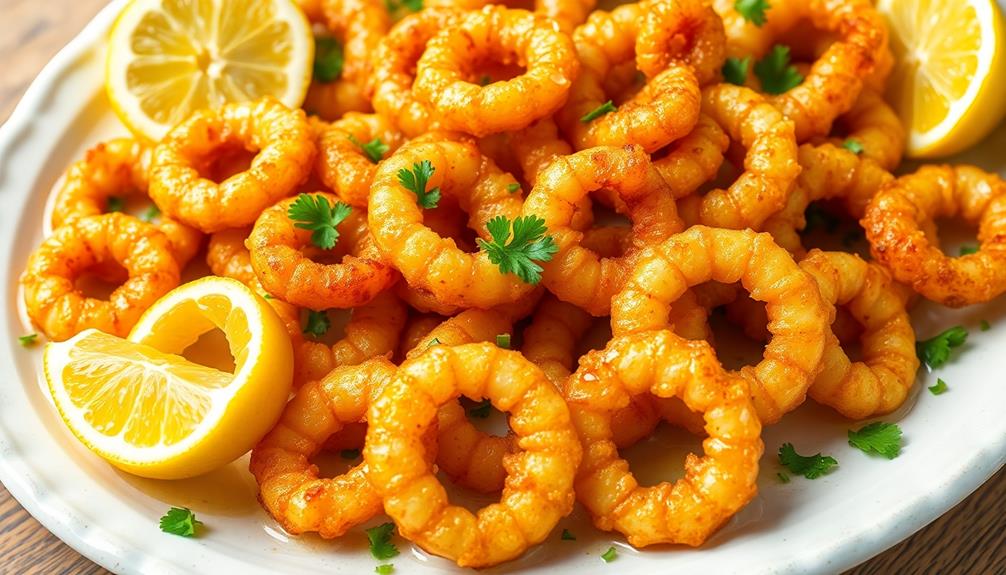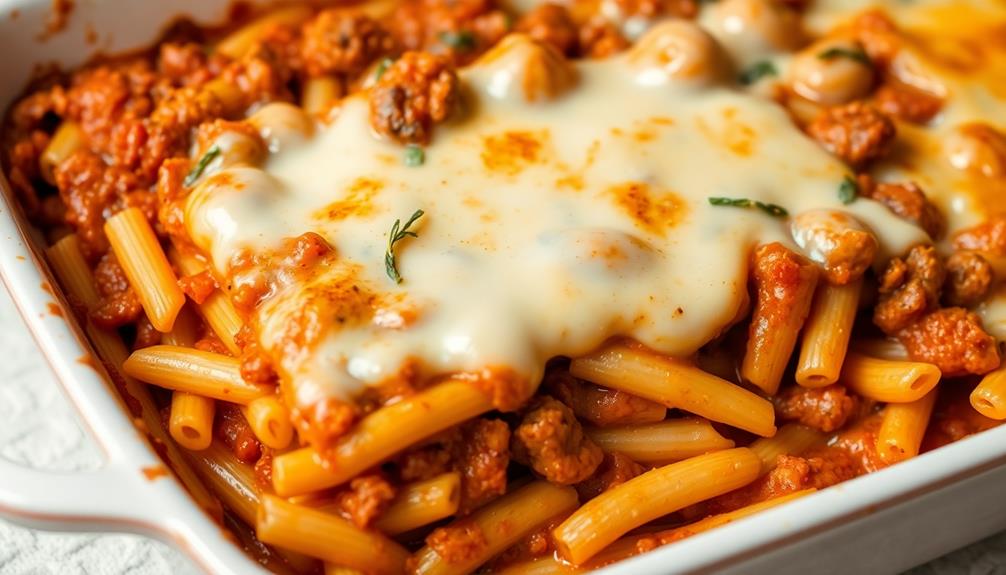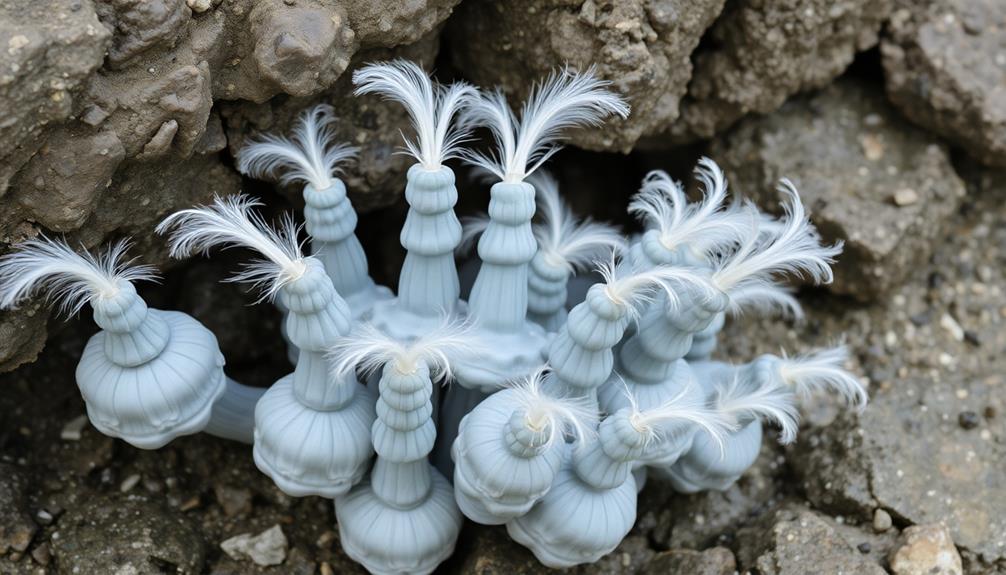Calamares a la Romana, the beloved fried squid rings, transport you to the vibrant coastal regions of Spain. This centuries-old dish showcases the tender and succulent nature of fresh calamari, coated in a flavorful flour blend and fried to crispy perfection. The key is to thoroughly dry the squid before dredging it in the seasoned flour, then frying it quickly in hot oil for that irresistible crunch. Served piping hot and garnished with lemon wedges, this tapas delight encourages sharing and bonding over a taste of Spanish culinary heritage. Discover more about the rich history and preparation of this captivating dish.
Key Takeaways
- Calamares a la Romana is a traditional Spanish dish featuring fresh, tender calamari rings that are coated in seasoned flour and fried until crispy.
- The dish traces its origins to the coastal regions of the Iberian Peninsula, with recipes dating back to the 16th century, and is a staple in Spanish tapas culture.
- The preparation involves thoroughly cleaning and drying the squid, dredging it in a seasoned flour mixture, and frying the rings in hot oil until golden brown and crisp.
- Calamares a la Romana is often served with lemon wedges, which can be squeezed over the fried squid to enhance the flavor, and it is commonly enjoyed as a shared appetizer or tapas dish.
- The dish is known for its savory and rich flavor profile, showcasing the quality and freshness of the calamari, and is celebrated as part of Spain's vibrant culinary heritage.
History
The origins of Calamares a la Romana, a beloved Spanish seafood dish, can be traced back to the coastal regions of the Iberian Peninsula.
This classic fried squid dish has been a part of the local cuisine for centuries, with early recipes dating back to the 16th century.
The name "Calamares a la Romana" translates to "squid in the Roman style," hinting at the dish's ancient Mediterranean roots.
Over time, the recipe has evolved, incorporating regional ingredients and cooking techniques.
Today, it remains a staple in Spanish tapas bars and family gatherings, enjoyed for its crispy texture and delicate flavor.
The dish's popularity has since spread throughout the world, allowing food enthusiasts everywhere to savor the taste of this iconic Spanish culinary tradition.
Recipe
Calamari, a delectable seafood delicacy, is a beloved dish in the coastal regions of Spain. Calamares a la Romana, a classic Spanish preparation, is a mouthwatering dish that showcases the tender and succulent nature of this marine creature. This recipe will guide you through the process of creating this flavorful and satisfying dish in the comfort of your own kitchen.
Originating from the Valencian region, Calamares a la Romana is a popular tapas item that has found its way into the hearts and stomachs of food enthusiasts worldwide. The combination of crispy fried calamari and the tangy, garlic-infused dipping sauce is a match made in culinary heaven.
- 1 lb. fresh calamari, cleaned and cut into rings
- 1 cup all-purpose flour
- 1 teaspoon paprika
- 1 teaspoon salt
- 1/2 teaspoon black pepper
- Vegetable oil for frying
- Lemon wedges for serving
In a large pot or Dutch oven, heat 2-3 inches of vegetable oil to 350°F. In a shallow bowl, combine the flour, paprika, salt, and pepper. Dredge the calamari rings in the seasoned flour, coating them evenly.
Carefully drop the coated calamari rings into the hot oil and fry for 2-3 minutes until golden brown and crispy. Transfer the fried calamari to a paper towel-lined plate to drain excess oil.
Serve the Calamares a la Romana immediately, accompanied by lemon wedges. The crisp, golden exterior and the tender, succulent interior of the calamari, combined with the acidity of the lemon, create a harmonious balance of flavors.
For an authentic experience, consider serving the dish with a garlic-infused mayonnaise or aioli dipping sauce on the side.
Cooking Steps
First, clean and dry the squid thoroughly.
Next, dredge the squid in the seasoned flour to coat it evenly.
Then, fry the squid in hot oil until it's crispy and golden brown.
Be sure to drain the excess oil from the fried squid before serving it immediately with lemon wedges on the side.
Step 1. Clean and Dry the Squid
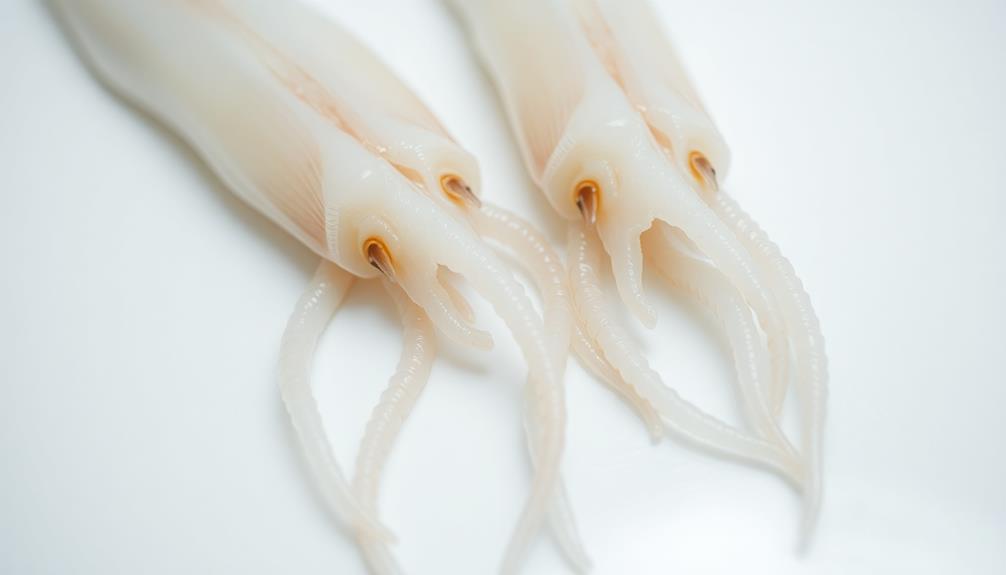
After cleaning the squid, it's crucial to thoroughly dry them. Use paper towels or a clean kitchen towel to pat the squid rings and tentacles until they're completely dry. This step is essential to ensure the squid fries up crispy and golden brown. Any excess moisture can cause the oil to splatter or the squid to become soggy.
Once the squid is dry, arrange the pieces in a single layer on a clean surface. This allows any remaining water to evaporate, further preparing the squid for the frying process.
Take your time with this step – you want the squid to be as dry as possible before moving on. Rushing through the drying can result in subpar fried squid, so be patient and thorough.
With the squid prepped and ready, you're one step closer to enjoying delicious Calamares a la Romana.
Step 2. Dredge Squid in Seasoned Flour

With the squid thoroughly dried, it's time to dredge them in a seasoned flour mixture. In a shallow bowl, combine all-purpose flour, paprika, garlic powder, and a pinch of salt and pepper. Stir the ingredients together until well mixed.
One by one, dip the squid rings into the flour mixture, turning to coat them evenly on all sides. Gently shake off any excess flour to prevent clumping during frying.
As you dredge each piece, transfer it to a clean plate or baking sheet, keeping them in a single layer. This seasoned flour coating will create a delightful crunch when the squid is fried.
The paprika adds a touch of smoky sweetness, while the garlic powder and salt and pepper enhance the overall flavor. Be sure to dredge all the squid pieces before moving on to the next step of the recipe.
Step 3. Fry Squid in Hot Oil
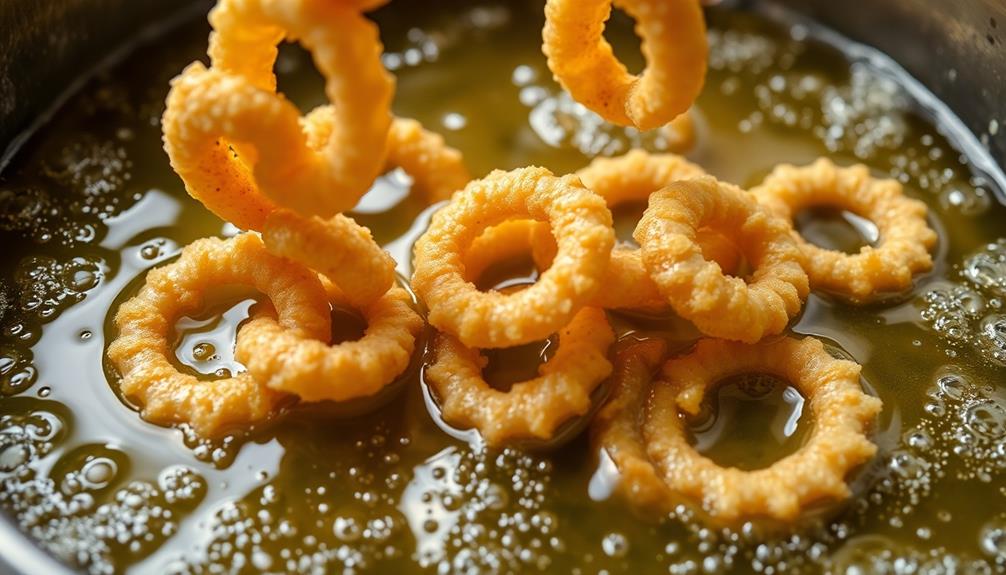
Once the squid is dredged in the seasoned flour, you'll want to fry them in hot oil until golden brown and crispy.
Heat about 1/2 inch of oil in a large skillet or Dutch oven over medium-high heat. When the oil is shimmering, carefully add the floured squid rings in a single layer, working in batches if needed.
Fry for 2-3 minutes per side, flipping once, until the squid is cooked through and the breading is crisp and golden. Be careful not to overcrowd the pan, as this can cause the oil temperature to drop and result in soggy squid.
Drain the fried squid on a paper towel-lined plate, and season with a sprinkle of salt while still hot.
Serve the calamares a la romana immediately, garnished with lemon wedges. The contrast of the crispy exterior and tender, slightly chewy interior makes for an irresistible fried squid dish.
Enjoy this classic Spanish tapas with friends and family for a truly festive experience.
Step 4. Drain Excess Oil From Fried Squid
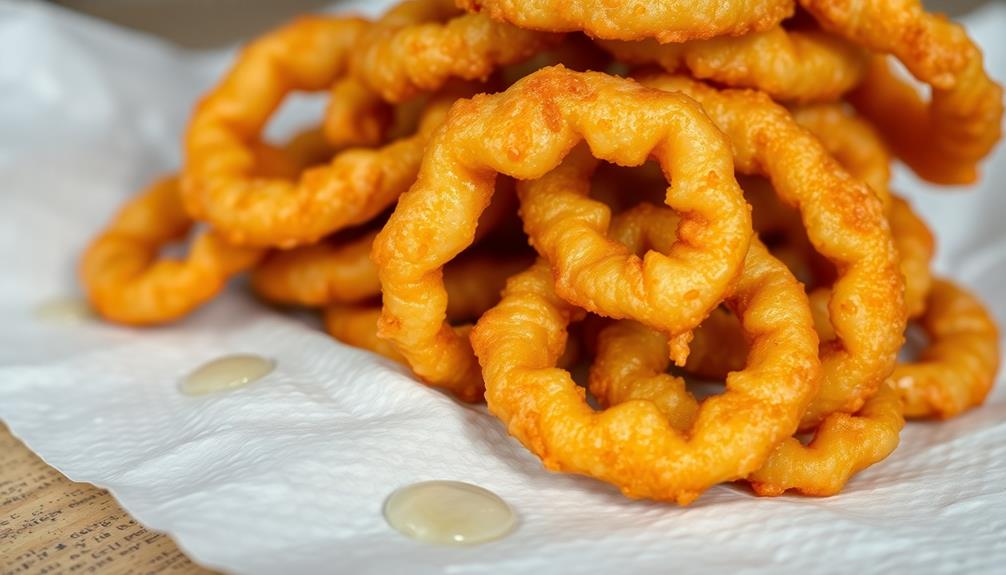
Carefully transfer the fried squid to a paper towel-lined plate to drain any excess oil.
This step is crucial to ensuring your calamares à la romana turn out crisp and not greasy.
Use a slotted spoon or tongs to gently lift the fried squid rings from the hot oil, letting any extra oil drip back into the pan.
Arrange the squid in a single layer on the paper towels, allowing the absorbent material to soak up the remaining oil.
This will give your fried calamares a light and crunchy texture.
Once the squid has drained, you can transfer it to a serving plate or bowl.
Be careful not to crowd the pieces, as this can cause the fried coating to become soggy.
With the excess oil removed, your calamares à la romana are now ready to be enjoyed in all their golden, crispy glory!
Step 5. Serve Immediately With Lemon Wedges

Serve the calamares à la romana immediately while they're hot and crispy.
Arrange the fried squid rings on a serving platter or plates. Garnish the dish with fresh lemon wedges, allowing your guests to squeeze the tangy juice over the tender squid. The lemon's acidity perfectly balances the rich, savory flavors and provides a refreshing contrast to the fried exterior.
Encourage your guests to pick up the calamares with their fingers and dip them into the lemon juice. This hands-on approach adds to the convivial, celebratory atmosphere.
For a more formal presentation, you can provide small plates and forks, but the traditional way is to enjoy these fried squid delights with your hands.
Serve the calamares à la romana immediately, as they're best when piping hot and crunchy.
The combination of the tender, succulent squid and the bright, citrusy lemon makes for a truly irresistible dish. Savor every bite and share this classic Spanish tapas with your loved ones.
Final Thoughts
Whether you're a seasoned seafood enthusiast or a curious culinary adventurer, the Calamares a La Romana dish you've just explored is a delightful triumph of flavor and texture. The crisp, golden-brown exterior gives way to the tender, succulent squid within, creating a sensory experience that's truly captivating.
As you savor the final bites, bask in the knowledge that you've mastered a classic Spanish tapas dish. The bright, tangy lemon wedges perfectly complement the rich, savory squid, making each mouthful a harmonious balance of flavors.
This recipe isn't only a culinary delight but also a testament to the vibrant culinary heritage of Spain. Whether enjoyed as a shared appetizer or a main course, Calamares a La Romana is sure to leave a lasting impression on your taste buds and your heart.
Embrace the joy of this dish and share it with loved ones, creating memories that will be cherished for years to come.
Frequently Asked Questions
What Type of Cooking Oil Is Best for Frying Squid?
You'll want to use a high smoke point oil like peanut, vegetable, or canola oil when frying squid. These oils can withstand the high heat needed to get a crispy, golden-brown exterior without burning.
Can I Use Frozen Squid Instead of Fresh?
You can certainly use frozen squid instead of fresh. The key is to thaw it completely before frying, ensuring it cooks evenly and crisps up nicely. Just be sure to pat it dry before breading or battering.
How Long Can Fried Squid Be Stored?
You can typically store fried squid for up to 3-4 days in the refrigerator, though the quality will diminish over time. To maintain freshness, store the fried squid in an airtight container and reheat before serving.
Is It Possible to Bake Calamares a La Romana?
You can definitely bake calamares, or fried squid rings, instead of frying them. Baking will result in a lighter, crispier texture compared to frying. Just be sure to toss the squid in oil and seasonings before baking.
Can I Substitute Any Other Seafood for the Squid?
Absolutely! You can substitute other types of seafood for squid in this dish. Shrimp, scallops, or even fish fillets would work well. Just adjust the cooking time as needed to ensure the seafood is cooked through.
